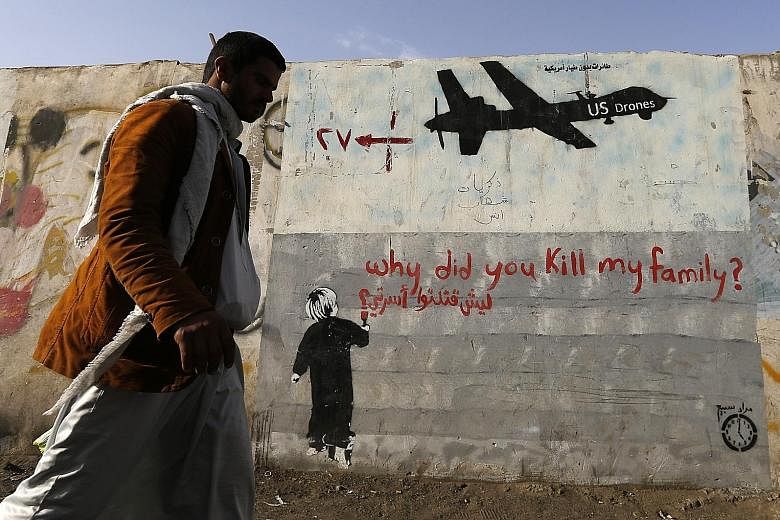WASHINGTON • Partially lifting the secrecy over one of the United States' most contentious tactics for fighting terrorists, the Obama administration said that it believed the air strikes it conducted outside conventional war zones such as Afghanistan have killed 64 to 116 civilian bystanders and about 2,500 terrorists.
The official civilian death count is far lower than estimates compiled by independent organisations that try to track what the government calls targeted killings, and human rights groups expressed doubts about the government's numbers.
Most of the strikes have been carried out by drones in chaotic places such as Libya, tribal Pakistan, Somalia and Yemen, though a small number have involved traditional aircraft or cruise missiles.
At the same time, US President Barack Obama issued an executive order making civilian protection a priority and requiring the government in the future to disclose the number of civilian deaths each year.
The order, which could be cancelled or altered by a future president, tries to commit his successors to greater openness than he has achieved in his first seven years in office.

For Mr Obama, the drone programme is personal, a defining feature of his presidency. As he expanded the use of drones beyond what president George W. Bush had begun, he took a direct role in approving some strikes, including the deliberate killing of an American, and in setting up rules to govern them.
The use of a range of estimated civilian deaths underscored the fact that the government often does not know for sure the affiliations of those killed. "They are guessing, too," said Mr Bill Roggio, editor of the Long War Journal at the Foundation for the Defence of Democracies, who has tracked civilian deaths for more than a decade.
"Theirs may be a little more educated than my guesses. But they cannot be completely accurate."
The disclosure about civilian deaths and the executive order, the subject of months of bureaucratic deliberations, carried broader significance. Issued about seven months before Mr Obama leaves office, the order further institutionalised and normalised air strikes outside conventional war zones as a routine part of 21st-century national security policy.
The order declares that "civilian casualties are a tragic and at times unavoidable consequence of the use of force in situations of armed conflict or in the exercise of a state's inherent right of self-defence" and lays out the "best practices" necessary to reduce their likelihood and "take appropriate steps" when they occur.
The estimated number of civilian deaths between Mr Obama's inauguration in 2009 and the end of 2015 was contained in a report issued by the Office of the Director of National Intelligence. It said the numbers came from 473 strikes, which also killed 2,372 to 2,581 "combatants".
The report named Afghanistan, Iraq and Syria as "areas of active hostilities" excluded from the policy. A senior administration official said tribal Pakistan - which the government treats as an extension of the Afghan battlefield in certain contexts - is not such an area; casualties there are part of the official civilian death toll.
It is an open secret that the majority of drone strikes have taken place there as CIA covert operations, which meant that the administra- tion's periodic pledges to be more transparent about targeted killings have not been completely fulfilled.
The executive order also said the annual reports from the Office of the Director of National Intelligence should address any discrepancy between the official body count and what outside groups estimate. That gap is striking.
The administration's count of civilian deaths is about half of the lowest estimate from independent watchdogs, which base their estimates largely on media reports and information from local officials.
Long War Journal, Washington- based security policy organisation New America and London-based Bureau of Investigative Journalism estimate that 200 to 800 civilians have been killed by US air strikes outside war zones since 2009.
The government report acknowledged that outside groups had published "significantly higher figures" but said their numbers relied on reports about events in remote and inaccessible areas that might be inaccurate or tainted by "terrorist propaganda".
The report also pushed back against the claim that the government, when counting civilian casualties, presumes that any military- age male killed in a strike zone is a combatant. It said a dead person from such a strike about whom nothing was known was presumed to be a non-combatant.
NEW YORK TIMES

